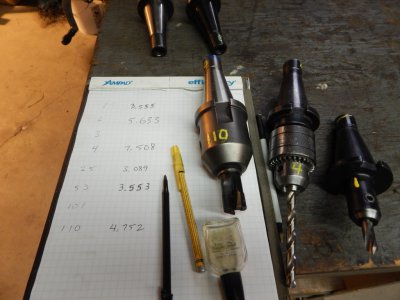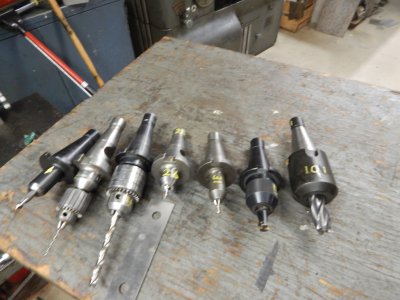-
Welcome back Guest! Did you know you can mentor other members here at H-M? If not, please check out our Relaunch of Hobby Machinist Mentoring Program!
You are using an out of date browser. It may not display this or other websites correctly.
You should upgrade or use an alternative browser.
You should upgrade or use an alternative browser.
Fn32 Right Side Plate
- Thread starter Karl_T
- Start date
- Joined
- Oct 14, 2014
- Messages
- 1,966
Next measure all the tools for height and diameter. Enter this into the control. The job must be perfect here. Or you'll schmuck a tool and make an awful crashing sound. DAMHIKT
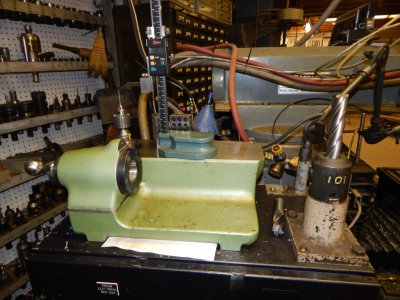
Here I'm setting part zero. Its exactly six inched below the quill frame.
This cnc is set up to move the knee by the part height minus the tool height at each tool change. For YEARS, I did this manually with a table written out by hand saying how much to crank the knee.
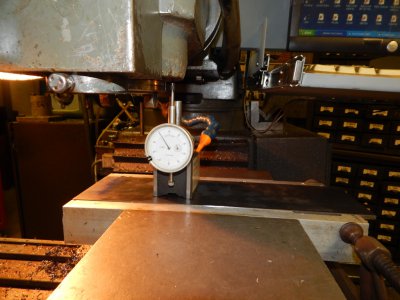

Here I'm setting part zero. Its exactly six inched below the quill frame.
This cnc is set up to move the knee by the part height minus the tool height at each tool change. For YEARS, I did this manually with a table written out by hand saying how much to crank the knee.

Last edited:
- Joined
- Oct 14, 2014
- Messages
- 1,966
Here's what I use to clamp the part. SOFT JAWS. You can see these have seen a lot of use from all the times the jaws have milling marks. For every use skin just a RCH off the side and bottom of the notch. Then everything is perfectly level and square.
I show some jaws for the six inch vice and another eight inch jaw is being used to clamp tight for the truing cut
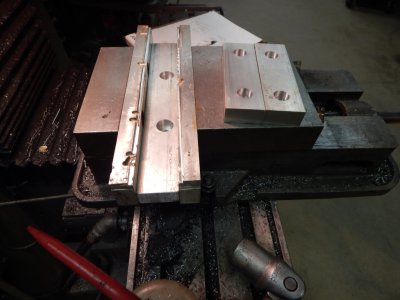
Ever need to clamp a warped part. The mill is pushing it down hard into the softjaws. You need something with give to judge how must down force there is.
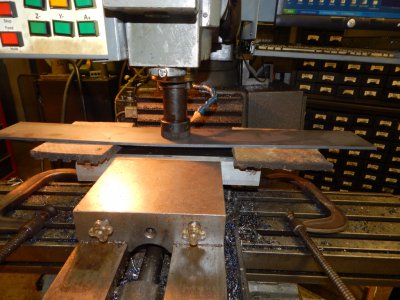
I show some jaws for the six inch vice and another eight inch jaw is being used to clamp tight for the truing cut

Ever need to clamp a warped part. The mill is pushing it down hard into the softjaws. You need something with give to judge how must down force there is.

Last edited:
- Joined
- Oct 14, 2014
- Messages
- 1,966
OK, time for some CNC machine porn...
Inside of receiver has the denial islands. This is required by the alphabet boys to keep full auto parts out.
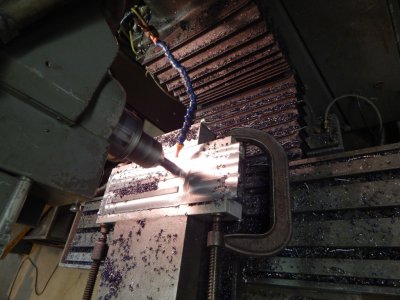
Next, the part has been flipped over to work on the outside. first op is spot drilling
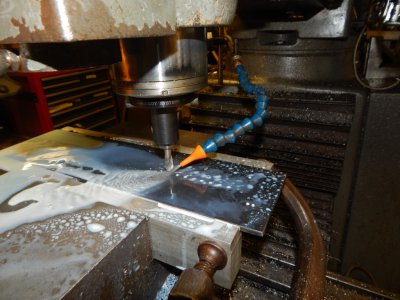
This is called chain drilling. A through slot for the charging handle goes here. If you chain drill first, the end mill has nowhere near as much work to do and there is a place for the chips to go.
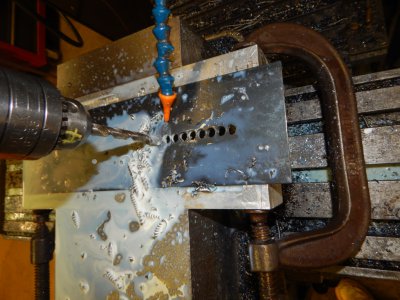
Inside of receiver has the denial islands. This is required by the alphabet boys to keep full auto parts out.

Next, the part has been flipped over to work on the outside. first op is spot drilling

This is called chain drilling. A through slot for the charging handle goes here. If you chain drill first, the end mill has nowhere near as much work to do and there is a place for the chips to go.

Last edited:
- Joined
- Oct 14, 2014
- Messages
- 1,966
The most difficult part of this job is the relieved area for lightening the receiver. Had to get real tricky here. Four passes 0.020 deep, each one farther from the top edge to form a 0.125 radius. See the G41 discussion earlier in the thread
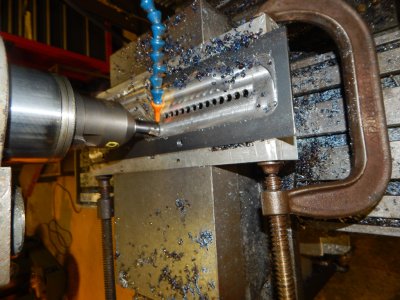
Here's the finish cut with a ball nose endmill. I got this endmill, used, off fleabay. It was chipped and worn out, So I took a diamond stone and trued up as best I could. That is why the previous cut had to be so close to perfect. this tool only shaved 5 thou at a time. New ones are only $200+
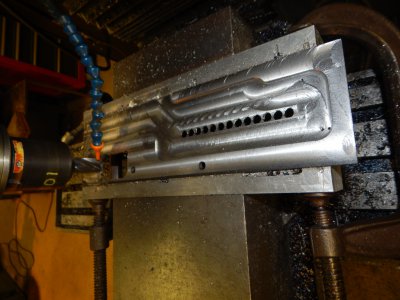

Here's the finish cut with a ball nose endmill. I got this endmill, used, off fleabay. It was chipped and worn out, So I took a diamond stone and trued up as best I could. That is why the previous cut had to be so close to perfect. this tool only shaved 5 thou at a time. New ones are only $200+

Last edited:
- Joined
- Oct 14, 2014
- Messages
- 1,966
Here's the charge handle slot being cut. Goes so nice'n'easy with all the chain drilling doen ahead of time. I meant to take a pic earlier in this tool's op. You can just barely see the top outline of the receiver is completely cut in some places and only cut to half depth in others. this keeps the part from falling out of the soft jaws.
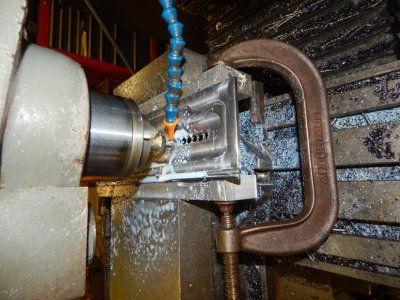
OK, the CNC work is done. Here, the part cut through areas are finished off with a band saw. The 1/2 depth slot makes a perfect guide to saw by.
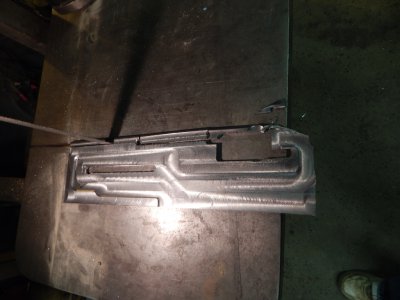

OK, the CNC work is done. Here, the part cut through areas are finished off with a band saw. The 1/2 depth slot makes a perfect guide to saw by.

- Joined
- Oct 14, 2014
- Messages
- 1,966
Plan A was to manually mill finish the top outline. Turns out its easier to just grind and file.Plus there are several square corners
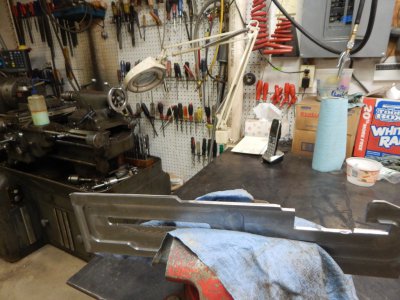
The proof is in the pudding, The part fits the weapon perfectly. Just so you know I ain't that good, part 1 (shown) was off 10 thou is several spots. Would have been "good enough" if I just wanted a shooter.
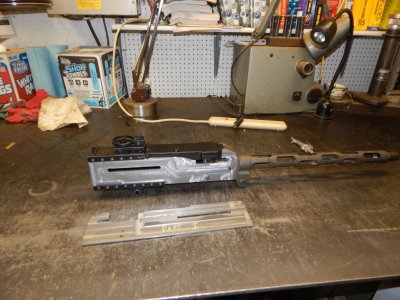

The proof is in the pudding, The part fits the weapon perfectly. Just so you know I ain't that good, part 1 (shown) was off 10 thou is several spots. Would have been "good enough" if I just wanted a shooter.

- Joined
- Oct 14, 2014
- Messages
- 1,966
OK, couple notes on the production run of five plates...
First, I love the Sandvick R390 inserts for rapid metal removal. But the chips come off blue hot and make a mess in the shop. So, I built this chip pan.
Not shown, I lay a USPS flat rate box top over the pan when running. Keeps 99% of the chips inside.
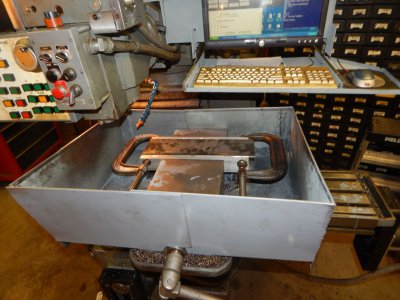
Also, had real trouble with part finish. The whole part was too thin and flexing away from the cutter, leaving chatter marks. So I build a support bar that couple be raised in place on a couple 1/2 x 13 bolts. For the heavy cut, put a piece of 1/8 rubber on top the support bar and just snug it up against the part. I scrapped a part making this too tight, it pushed it right out of the soft jaws and the part was too thin.
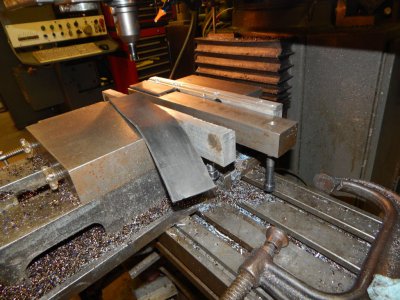
First, I love the Sandvick R390 inserts for rapid metal removal. But the chips come off blue hot and make a mess in the shop. So, I built this chip pan.
Not shown, I lay a USPS flat rate box top over the pan when running. Keeps 99% of the chips inside.

Also, had real trouble with part finish. The whole part was too thin and flexing away from the cutter, leaving chatter marks. So I build a support bar that couple be raised in place on a couple 1/2 x 13 bolts. For the heavy cut, put a piece of 1/8 rubber on top the support bar and just snug it up against the part. I scrapped a part making this too tight, it pushed it right out of the soft jaws and the part was too thin.

Last edited:
- Joined
- Oct 14, 2014
- Messages
- 1,966
OK, next op is cutting the top edges to correct height and thinning the top cover area from 0.187 to 0.125 thick
First job is build a good fixture, the key to machining anything. This is just a 5"x 15" x 3/4 bar and a 2" x 12" x 1/2" plate with holes drilled to go through the receiver charge handle and just in front of the ammo slot. Clamp the large bar in the vice. the top edge of the vice locates the bottom of the part for height.
I used "Manual NC" here. that is record your machine steps and do the same thing five times. I'm keeping this fixture for the future and recording my machine notes here. I always print out the instructions and tape to the fixture.
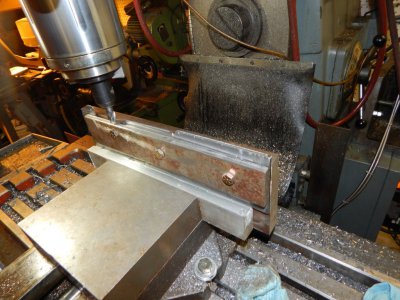
1. Set Z(knee) Zero at 3.588 overall height of RSP.
2. set X0 at front edge of ammo slot cut, 1/2" cutter to left.
3. set Y0 on front side of RSP, cutter to front
4.Machine top to knee 0 3.588 height
5. set Z level down 0.213- on knee to 3.375 height
6. machine top from x0 to x4.30
7.set Z level down to 0.388- on knee to 3.200 height
8. Machine from X0 to X 3.2 on front edge from Y0 to Y0.062, part thickness 0.125"
First job is build a good fixture, the key to machining anything. This is just a 5"x 15" x 3/4 bar and a 2" x 12" x 1/2" plate with holes drilled to go through the receiver charge handle and just in front of the ammo slot. Clamp the large bar in the vice. the top edge of the vice locates the bottom of the part for height.
I used "Manual NC" here. that is record your machine steps and do the same thing five times. I'm keeping this fixture for the future and recording my machine notes here. I always print out the instructions and tape to the fixture.

1. Set Z(knee) Zero at 3.588 overall height of RSP.
2. set X0 at front edge of ammo slot cut, 1/2" cutter to left.
3. set Y0 on front side of RSP, cutter to front
4.Machine top to knee 0 3.588 height
5. set Z level down 0.213- on knee to 3.375 height
6. machine top from x0 to x4.30
7.set Z level down to 0.388- on knee to 3.200 height
8. Machine from X0 to X 3.2 on front edge from Y0 to Y0.062, part thickness 0.125"


